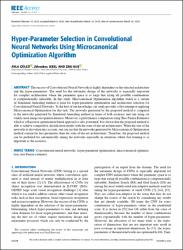Hyper-Parameter Selection in Convolutional Neural Networks Using Microcanonical Optimization Algorithm
Citation
GÜLCÜ, Ayla, & Zeki KUŞ. "Hyper-Parameter Selection in Convolutional Neural Networks Using Microcanonical Optimization Algorithm." IEEE Access, 8 (2020): 52528-52540.Abstract
The success of Convolutional Neural Networks is highly dependent on the selected architecture
and the hyper-parameters. The need for the automatic design of the networks is especially important
for complex architectures where the parameter space is so large that trying all possible combinations
is computationally infeasible. In this study, Microcanonical Optimization algorithm which is a variant
of Simulated Annealing method is used for hyper-parameter optimization and architecture selection for
Convolutional Neural Networks. To the best of our knowledge, our study provides a rst attempt at applying
Microcanonical Optimization for this task. The networks generated by the proposed method is compared
to the networks generated by Simulated Annealing method in terms of both accuracy and size using six
widely-used image recognition datasets. Moreover, a performance comparison using Tree Parzen Estimator
which is a Bayesion optimization-based approach is also presented. It is shown that the proposed method is
able to achieve competitive classi cation results with the state-of-the-art architectures. When the size of the
networks is also taken into account, one can see that the networks generated by Microcanonical Optimization
method contain far less parameters than the state-of-the-art architectures. Therefore, the proposed method
can be preferred for automatically tuning the networks especially in situations where fast training is as
important as the accuracy.



















